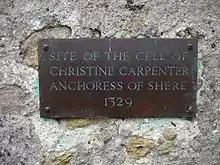Anchorite
An anchorite or anchoret (female: anchoress) is someone who, for religious reasons, withdraws from secular society so as to be able to lead an intensely prayer-oriented, ascetic, or Eucharist-focused life. Whilst anchorites are frequently considered to be a type of religious hermit,[2] unlike hermits they were required to take a vow of stability of place, opting for permanent enclosure in cells often attached to churches. Also unlike hermits, anchorites were subject to a religious rite of consecration that closely resembled the funeral rite, following which they would be considered dead to the world, a type of living saint. Anchorites had a certain autonomy, as they did not answer to any ecclesiastical authority other than the bishop.[3]




The anchoritic life is one of the earliest forms of Christian monasticism. In the Catholic Church today, it is one of the "Other Forms of Consecrated Life" and governed by the same norms as the consecrated eremitic life. In England, the earliest recorded anchorites existed in the 11th century. Their highest number—around 200 anchorites—were recorded in the 13th century.[4]
From the 12th to the 16th centuries, female anchorites consistently outnumbered their male counterparts, sometimes by as many as four to one (in the 13th century), dropping eventually to two to one (in the 15th century).[5]:11 The gender of a high number of anchorites, however, is not recorded for these periods.[6]
Between 1536 and 1539, the Dissolution of the Monasteries ordered by Henry VIII effectively brought the anchorite tradition to an end in England.
Anchoritic life
The anchoritic life became widespread during the early and high Middle Ages.[7] Examples of the dwellings of anchorites and anchoresses survive, a large number of which are in England. They tended to be a simple cell (also called anchorhold), built against one of the walls of the local village church.[8] In Germanic-speaking areas, from at least the 10th century, it was customary for the bishop to say "The Office of the Dead" as the anchorite entered their cell, to signify the anchorite's death to the world and rebirth to a spiritual life of solitary communion with God and the angels. Sometimes, if the anchorite was walled up inside the cell, the bishop would put his seal upon the wall to stamp it with his authority. Some anchorites, however, freely moved between their cells and the adjoining churches.[9]
Most anchoritic strongholds were small, perhaps no more than 3.7 to 4.6 m (12 to 15 ft) square, with three windows. Viewing the altar, hearing Mass, and receiving the Eucharist were possible through one small, shuttered window in the common wall facing the sanctuary, called a "hagioscope" or "squint". Anchorites provided spiritual advice and counsel to visitors through these windows, gaining a reputation for wisdom.[10] Another small window allowed access to those who saw to the anchorite's physical needs. A third window, often facing the street but covered with translucent cloth, allowed light into the cell.[3]
Anchorites committed to a life of uncompromising enclosure that could not be reversed at any time. Those who attempted to escape were returned by force and their souls damned to Hell.[11]:93[n 1] Some were burned in their cells, which they refused to leave even when pirates or looters were pillaging their towns.[12] They ate frugal meals, spending their days both in contemplative prayer and interceding on behalf of others. Their bodily waste was managed by means of a chamber pot.[13] Some anchorholds had a few small rooms or attached gardens. Servants tended to the basic needs of anchorites, providing food and water and removing waste. Julian of Norwich, for example, is known to have had several maidservants, among them Sara and Alice. Aelred of Rievaulx, who wrote an anchorite rule book, De Institutione Inclusarum, for his sister, a recluse, in c. 1161,[14] suggested keeping no housemates other than an old woman to act as companion and doorkeeper and a young maid as domestic servant.[15]
In addition to being the physical location wherein the anchorite could embark on a journey toward union with God, the anchorhold also provided a spiritual and geographic focus for people from the wider society seeking spiritual advice and guidance. Though set apart from the community at large by stone walls and specific spiritual precepts, the anchorite lay at the very center of the community. The anchorhold has been called a communal "womb" from which would emerge an idealized sense of a community's own reborn potential, both as Christians and as human subjects.[6]
Influential texts
An idea of their daily routine can be gleaned from an anchoritic rule. The most widely known today is the early 13th-century text known as Ancrene Wisse.[16] Another, less widely known, example is the rule known as De Institutione Inclusarum written in the 12th century, around 1160–1162, by Aelred of Rievaulx for his sister.[17] It is estimated that the daily set devotions detailed in Ancrene Wisse would take some four hours, on top of which anchoresses would listen to services in the church and engage in their own private prayers and devotional reading.[18]
Richard Rolle, an English hermit and mystic, wrote one of the most influential guide books regarding the life of an anchoress. His book, The Form of Living, was addressed to a young anchoress named Margaret Kirkby, who was responsible for preserving his texts.[19]:29 Her connection to the town of Hampole has been commonly associated with Rolle; indeed, he is sometimes referred to as Richard Rolle of Hampole despite a lack of conclusive evidence that Rolle indeed was ever in the small village.[20]
Rolle's book is based on the principles of mysticism and divided into twelve chapters:
- Chapter One: Rolle discusses the three weaknesses of humans: "lack of spiritual vigor, putting bodily desires into practice and exchanging a permanent good for a transitory pleasure."[21]
- Chapter Two: Rolle tells Mary that while her body may be sacrificing, her heart and soul will feel the ultimate pleasure of religious devotion.
- Chapter Three: Public display of piety does not promise holiness, but people who "follow Jesus Christ in voluntary poverty, and in humility, in love and in patience," can begin to be reckoned devout.[21]
- Chapter Four: Anchorites must give themselves fully to Jesus and reflect on the shortness of life, the question of the soul's final destination, the need to account for how one spends one's life, and the joy of perseverance.[21]
- Chapter Five: Rolle cautions against "unwise austerity".[21]
- Chapter Six: A pure heart, for which the anchorite strives, must understand "what things corrupt, what things purify, what preserves purity, and what induces submission to the will of God."[21]
- Chapter Seven: Rolle argues that a life of solitude is the best way to devote oneself to Jesus Christ.
- Chapter Eight: The three degrees of God's love are insuperable (robust and constant), inseparable (present), and singular (entirely devoted to Jesus Christ). He offers the analogy: the first degree is like the stars, the second degree like the moon, and the third degree like the sun.[21]
- Chapter Nine: Rolle claims that the name of Jesus must always be "fixed in the heart."[21]
- Chapter Ten: Rolle asks: "How am I to love God?" He provides seven ways in which love can be recognized: shedding the desire for material things, desire only for God and belief that the world holds nothing necessary, talking about God instead of worldly things, pursuit of activities of spiritual benefit, ease in completion of things formerly difficult, boldness to endure sorrow, and joy in the face of worldly anxieties.[21]
- Chapter Eleven: The seven gifts of the Holy Spirit.[21]
- Chapter Twelve: The contrast between the active and contemplative life.[21]
Notable anchorites
The earliest recorded anchorites lived in the 3rd century AD. For example, Hilarion (Gaza, 291–Cyprus, 371) was known as the founder of anchoritic life in Palestine.[22]
The anchoritic life proved popular in England, where women outnumbered men in the ranks of the anchorites, especially in the 13th century.[23] The evidence supports the existence of a total of around 780 anchorites on six hundred sites between 1100 and 1539, when the Dissolution of the Monasteries ordered by Henry VIII brought anchoritism in England to an end.[24]:32–37 English anchorholds can still be seen at Chester-le-Street in County Durham and at Hartlip in Kent.[25]
- Bede records that prior to a conference in 602 with Augustine of Canterbury, British churchmen consulted an anchorite about whether to abandon their Celtic Christian traditions for the Roman practices Augustine was seeking to introduce.[26]:103–119
- Toward the end of the 7th century, Guthlac of Crowland, related by blood to the Kingdom of Mercia, withdrew from the monastery at Repton to an island in the Lincolnshire Fens, where he lived for some fifteen to twenty years.[27]
- Wulfric of Haselbury was enclosed as an anchorite in a cell built against the church in his village of Haselbury Plucknett.[28]
- Christine Carpenter, who submitted a petition in 1329[29] and was granted permission to become the anchoress of Shere Church[30] (also known as The Church of St. James) in the Borough of Guildford, received her food and drink through a metal grating on the outside wall. In the interior of the church, a quatrefoil through which she could receive the Eucharist and a hagioscope for her use for prayer and reflection were cut out of the wall. Although she left her cell, in 1332 she applied for—and was granted—permission to be re-enclosed.[1]
- Katherine of Ledbury, anchorite at Ledbury, Herefordshire in the early 14th century.
- Margaret Kirkby (possibly 1322[31] to 1391–4), an anchoress at Hampole, for whom Richard Rolle wrote his vernacular guide The Form of Living.[32]
- Walter Hilton composed the first book of his Scale of Perfection for an unnamed enclosed woman.[33]
- Julian of Norwich, whose writings left a lasting impression on Christian spirituality.[34] Her cell, attached to St Julian's Church, Norwich, was destroyed during an air raid during World War II. The church itself was gutted, but the original walls remain, and it was rebuilt. On the site of the cell is a modern shrine to Julian.[35]
- Nazarena of Jesus, née Julia Crotta, was an American who felt called to become an anchorite and entered the Camaldolese Abbey of Sant'Antimo in Rome in 1945, remaining there until her death in 1990.[36]
Notable people
See also
References
Notes
- "The cell of enclosure, however, was equated with a prison into which the anchorite propelled himself for fear of hell and for love of Christ. The etemal punishment of hell might be escaped by the lifetime refusal of escape from the anchorhold. At the same time union with Christ might be achieved even in this life."—A. K. Warren, Anchorites and Their Patrons in Medieval England
Citations
- Wyndham Thomas (2012). Robert Saxton: Caritas. Ashgate Publishing, Ltd. pp. 16–20. ISBN 978-0-7546-6601-1.
- BBB Radio 4: Making History – Anchorites
- LePan, Don (2011). The Broadview Anthology of British Literature. Broadview Press. p. 348.
- The Code of Canon Law 1983, canon 603
- McAvoy, L. H., ed., Anchoritic Traditions of Medieval Europe (Suffolk: Boydell Press, 2010), p. 11.
- Herbert McAvoy, Liz (2005). Anchorites, Wombs And Tombs : Intersections Of Gender And Enclosure In The Middle Ages. University of Wales. p. 13.
- McAvoy 2010, p. 96.
- Licence 2013, p. 87–9.
- Licence 2013, p. 123, 120.
- Licence 2013, p. 158-72.
- Warren, A. K., Anchorites and Their Patrons in Medieval England (Oakland: University of California Press, 1985), p. 93.
- Licence 2013, p. 77-9.
- The Anchoress (2008-06-02). On-line Q&As. Retrieved in 2008-10 from http://theanchoressonline.com/2008/06/02/questions-comments-from-the-email/ Archived 2008-09-24 at the Wayback Machine.
- Wellesley, M., "The Life of the Anchoress", Discovering Literature: Medieval, British Library, March 13, 2018."
- Adamson, J. W., A Short History of Education (Cambridge: Cambridge University Press, 1919), p. 75.
- Ancrene Wisse
- Translated by Mary Paul MacPherson in Treatises and the Pastoral Prayer, Cistercian Fathers Series 2, (Kalamazoo, 1971). In English the work is variously titled The Eremitical Life, The Rule of Life for a Recluse and The Training of Anchoresses.
- Ancrene Wisse: Guide for Anchoresses, trans. H. White (London: Penguin Books, 1993), p. viii.
- Roman, C. M., Queering Richard Rolle: Mystical Theology and the Hermit in Fourteenth-Century England (London: Palgrave Macmillan, 2017), p. 29.
- Hughes, Jonathan. "Rolle, Richard (1305×10–1349)". Oxford Dictionary of National Biography (online ed.). Oxford University Press. doi:10.1093/ref:odnb/24024. (Subscription or UK public library membership required.)
- "Richard Rolle's Form of Living: A Medieval Guide for an Anchoress - Articles - House of Hermits - Hermitary". www.hermitary.com. Retrieved 2018-12-17.
- Catholic Encyclopedia, St. Jerome, Vita Sancti Hilarionis in P. L., III, 29-54.
- Ancrene Wisse, trans Hugh White, (Penguin, 1993)
- Erler, M. C., Reading and Writing during the Dissolution: Monks, Friars, and Nuns 1530–1558 (Cambridge: Cambridge University Press, 2013), pp. 32–37.
- Hughes-Edwards, M., "Anchoritism: the English Tradition", in L. H. McAvoy, Anchoritic Traditions of Medieval Europe (Suffolk: Boydell Press, 2010), p. 143.
- Grimmer, M., "Bede and the Augustine's Oak conferences: Implications for Anglo-British ecclesiastical interaction in early Anglo-Saxon England", Journal of the Australian Early Medieval Association, Nr. 2, January 2006, pp. 103–119.
- Ancrene Wisse, trans Hugh White, (Penguin, 1993), p.xiii
- Monks of Ramsgate. “Ulrick”. Book of Saints, 1921. CatholicSaints.Info. 17 February 2017
 This article incorporates text from this source, which is in the public domain.
This article incorporates text from this source, which is in the public domain. - Petition to Become an Anchoress University of Saint Thomas–Saint Paul, MN, http://courseweb.stthomas.edu, 2003, 2012-04-22
- History of Shere, sheredelight.com, 2011, 2012-04-22
- Jonathan Hughes, 'Kirkby, Margaret (d. 1391x4)', Oxford Dictionary of National Biography, Oxford University Press, 2004. Retrieved on 2011-05-06 from https://www.oxforddnb.com/view/article/57764.
- Ancrene Wisse, trans Hugh White, (Penguin, 1993), p.xiii
- Hilton, W., The Scale of Perfection, tr. J. P. Clark & R. Dorward (New York City: Paulist Press, 1991), p. 19.
- Revelations of Divine Love
- Milton, R., Julian's Cell: The Earthy Story of Julian of Norwich (Kelowna, B.C.: Northstone Publishing, 2002).
- Chalupsky, Mary. "Glastonbury native led ascetic life in Rome", Catholic Transcript, Archdiocese of Hartford
Bibliography
- "About Anchorites." Hermits & Anchorites : About Anchorites, University of Exeter, 2010, hermits.ex.ac.uk/index/anchorites.
- Britannica, The Editors of Encyclopaedia. "Great Chain of Being." Encyclopædia Britannica, Encyclopædia Britannica, Inc., 27 May 2015, www.britannica.com/topic/Great-Chain-of-Being.
- Dixon, Alan. "The 'Great Chain of Being'." Inner Civilization, 1 Jan. 1970, www.innercivilization.com/2010/03/great-chain-of-being.html.
- Hughes-Edwards, Mari (2012). Reading Medieval Anchoritism: Ideology and Spiritual Practices. University of Wales Press. ISBN 9780708325049.
- Licence, Tom (2013). Hermits and Recluses in English Society, 950-1200. OUP Oxford. ISBN 978-0-19-967409-1.
- McAvoy, Liz (2010). Anchoritic Traditions of Medieval Europe. Boydell & Brewer. ISBN 978-1-84383-520-2.
- "Richard Rolle's Form of Living: A Medieval Guide for an Anchoress." Tao Chien (Tao Yuan-Ming), Poet of Reclusion - Articles - House of Hermits - Hermitary, 2006, www.hermitary.com/articles/rolle.html.
Further reading
- Healy, John (1892). . The Ancient Irish Church (1 ed.). London: Religious Tract Society. pp. 82–88.
- Warren, Ann K. (1985). "Anchorites and their Patrons in Medieval England". Berkeley: University of California Press. ISBN 0520052781
External links
| Wikimedia Commons has media related to Anchorites. |
| Wikiquote has quotations related to: Anchorite |
Historical development
- The Anchorhold at All Saints Church, King's Lynn, Norfolk
- Chapter 1 of The Rule of Saint Benedict re: Anchorites
- The Way of an Anchoress
- Anchorite Cell at St Luke's Church in Duston
- Marsha, Anchoritic Spirituality in Medieval England: The Form, the Substance, the Rule
- Rotha Mary Clay, Full Text plus illustrations, The Hermits and Anchorites of England.
- Rotha Mary Clay, The Hermits and Anchorites of England, Chapter VII: Anchorites in Church and Cloister
- Ancrene Wisse, Introduction
- anchorite?
- digitised copy of a British Library manuscript of the Ancrene Wisse, a rule for anchoresses written in the 13th century